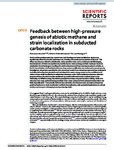Feedback between high-pressure genesis of abiotic methane and strain localization in subducted carbonate rocks
| dc.contributor.author | Giuntoli, F | en |
| dc.contributor.author | Vitale Brovarone, A | en |
| dc.contributor.author | Menegon, L | en |
| dc.date.accessioned | 2021-10-22T12:00:15Z | |
| dc.date.issued | 2020-06-17 | en |
| dc.identifier.issn | 2045-2322 | en |
| dc.identifier.other | 9848 | en |
| dc.identifier.uri | http://hdl.handle.net/10026.1/18155 | |
| dc.description.abstract |
<jats:title>Abstract</jats:title><jats:p>Fluid-rock interactions exert key control over rock rheology and strain localization. Redox may significantly affect the reaction pathways and, thereby, the mechanical properties of the rock. This effect may become critical in volatile-rich, redox sensitive rocks such as carbonate-rich lithologies, the breakdown of which can significantly modify the net volume change of fluid-mediated reactions. Subduction focus the largest recycling of crustal carbonates and the most intense seismic activity on Earth. Nevertheless, the feedbacks between deep carbon mobilization and deformation remain poorly investigated. We present quantitative microstructural results from natural samples and thermodynamic modeling indicating that percolation of reducing fluids exerts strong control on the mobilization of carbon and on strain localization in subducted carbonate rocks. Fluid-mediated carbonate reduction progressed from discrete domains unaffected by ductile deformation into localized shear zones deforming via diffusion creep, dissolution-precipitation creep and grain boundary sliding. Grain-size reduction and creep cavitation along localized shear zones enhanced fluid-carbonate interactions and fluid channelization. These results indicate that reduction of carbonate rocks can exert an important positive feedback on strain localization and fluid channelization, with potential implications on seismic activity and transport of deep hydrocarbon-bearing fluids.</jats:p> | en |
| dc.language | en | en |
| dc.language.iso | en | en |
| dc.publisher | Nature Research | en |
| dc.title | Feedback between high-pressure genesis of abiotic methane and strain localization in subducted carbonate rocks | en |
| dc.type | Journal Article | |
| plymouth.issue | 1 | en |
| plymouth.volume | 10 | en |
| plymouth.journal | Scientific Reports | en |
| dc.identifier.doi | 10.1038/s41598-020-66640-3 | en |
| plymouth.organisational-group | /Plymouth | |
| plymouth.organisational-group | /Plymouth/Faculty of Science and Engineering | |
| plymouth.organisational-group | /Plymouth/REF 2021 Researchers by UoA | |
| plymouth.organisational-group | /Plymouth/REF 2021 Researchers by UoA/UoA07 Earth Systems and Environmental Sciences | |
| dcterms.dateAccepted | 2020-05-08 | en |
| dc.rights.embargodate | 2021-10-23 | en |
| dc.identifier.eissn | 2045-2322 | en |
| dc.rights.embargoperiod | Not known | en |
| rioxxterms.versionofrecord | 10.1038/s41598-020-66640-3 | en |
| rioxxterms.licenseref.uri | http://www.rioxx.net/licenses/all-rights-reserved | en |
| rioxxterms.licenseref.startdate | 2020-06-17 | en |
| rioxxterms.type | Journal Article/Review | en |


